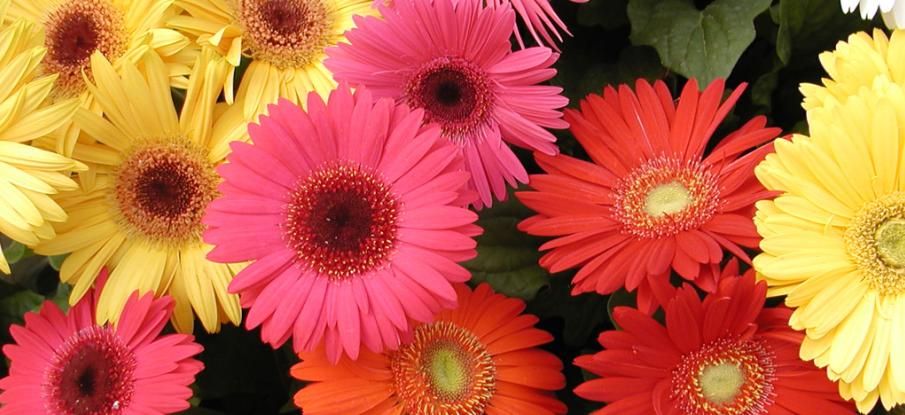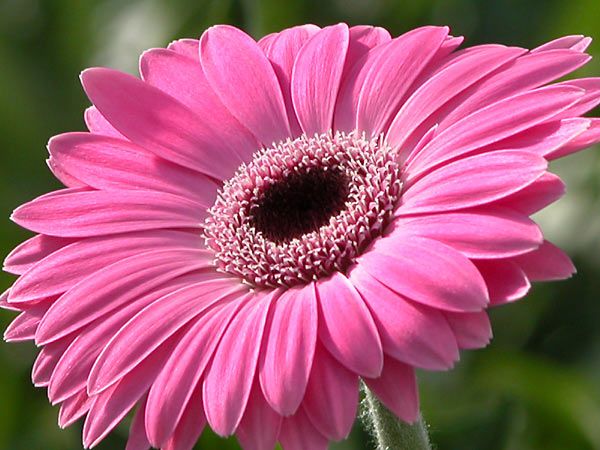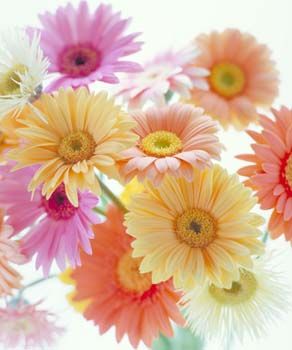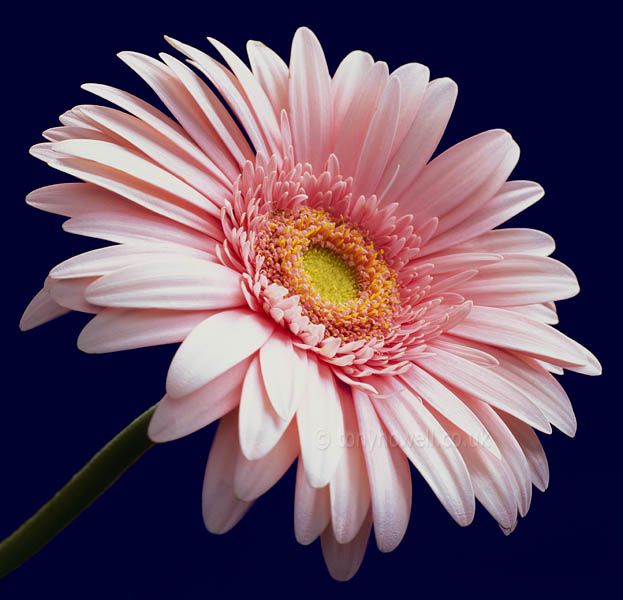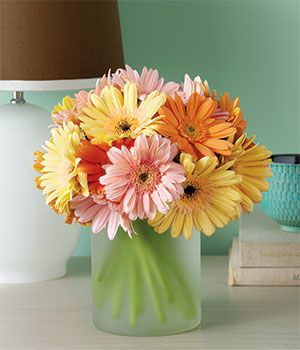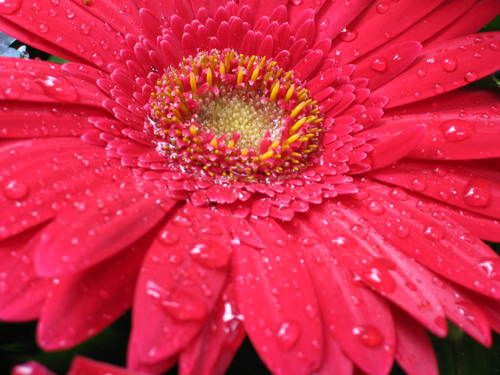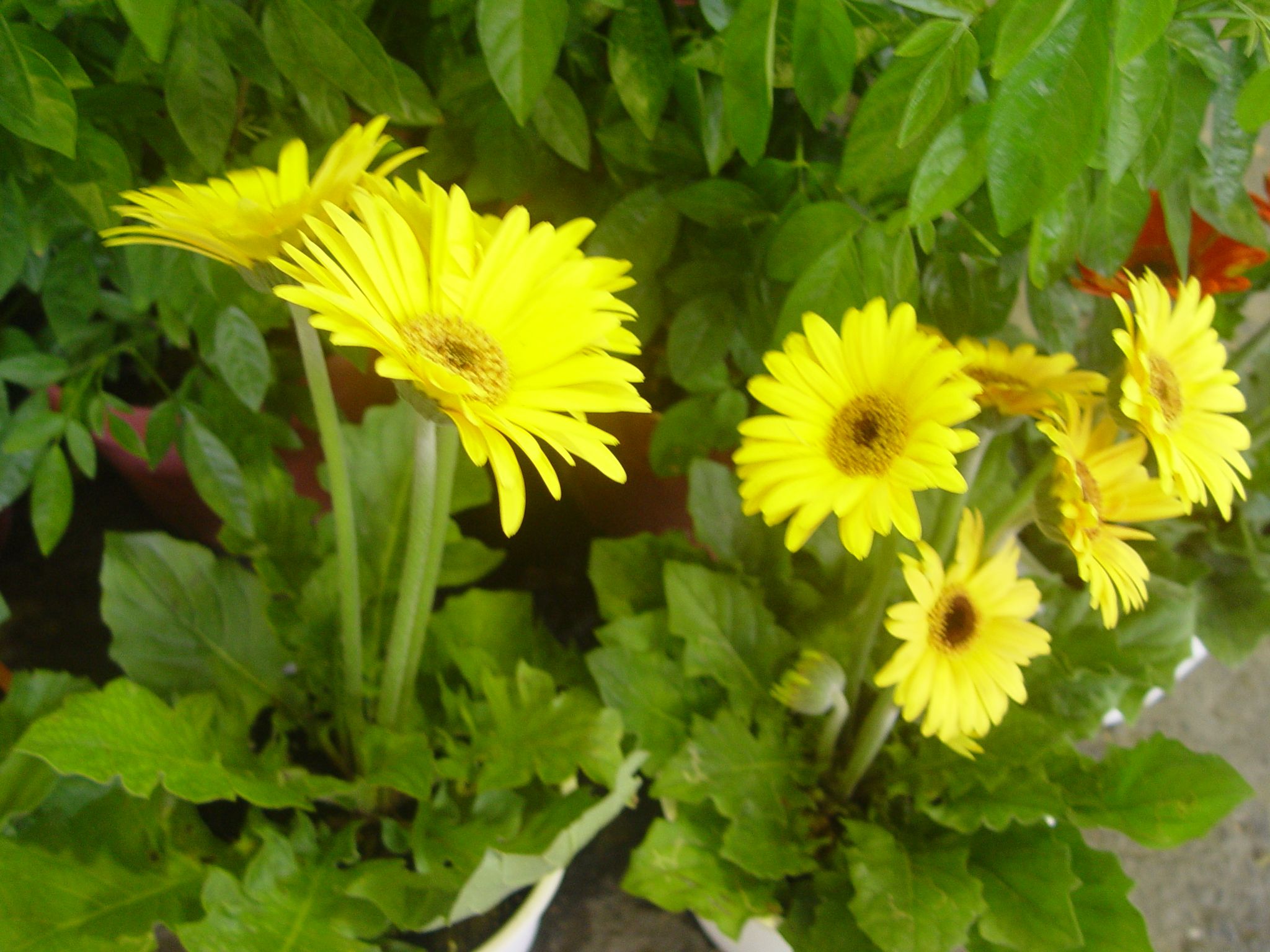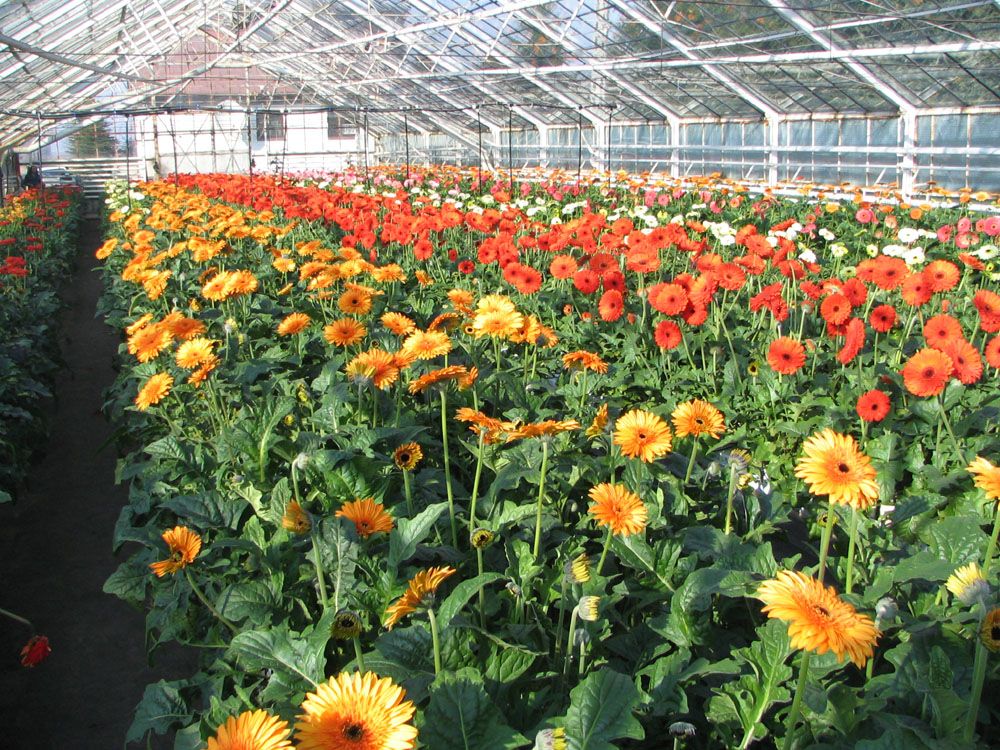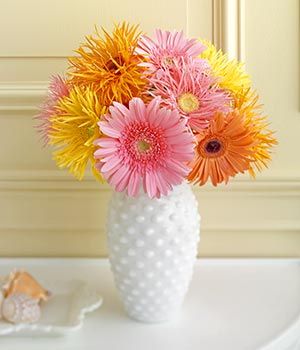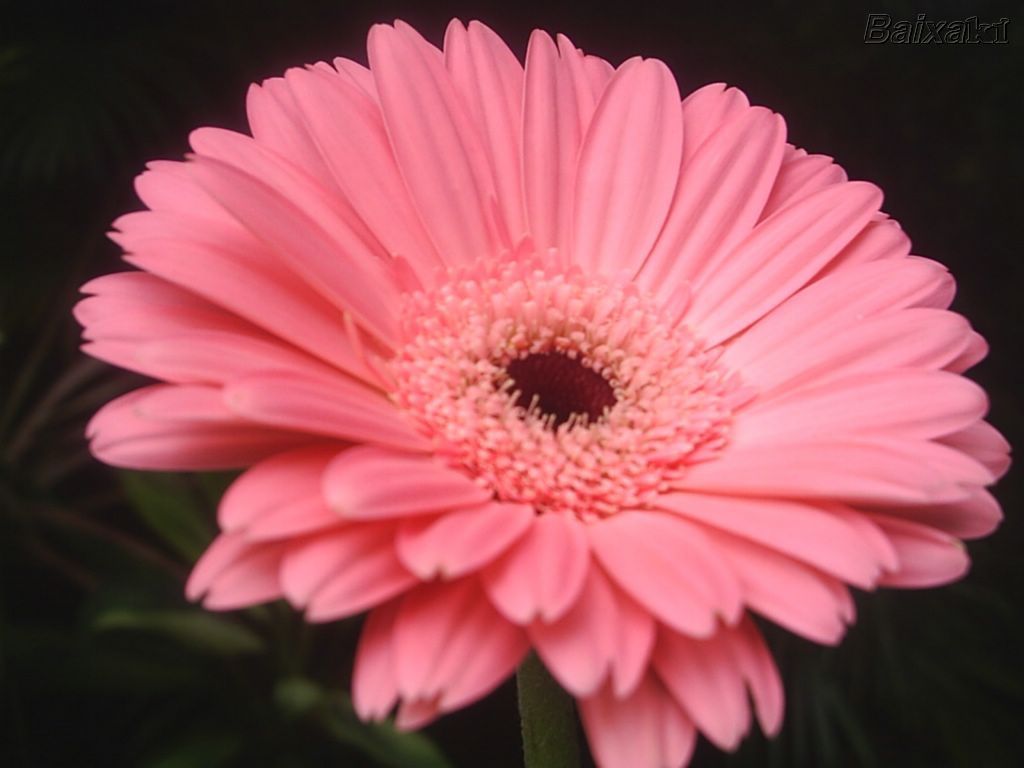Gerbera
Scientific name: Gerbera jamesonii
Common name: Gerbera, Barberton daisy, African daisy, Transvaal daisy
Family: Asteraceae
Native to: South Africa
Flowering time: Summer to Autumn
Height: 45 cm
Width: 45 cm
Planting depth and spacing: Plant with crown at soil surface (or just above) and approximately 45cm apart
Soil: Natural deep drained sandy / light soils. Require perfect drainage. Otherwise fungal diseases can occur.
Position: Open and sunny. Is frost sensitive and needs protection from strong wind.
Watering: Regularly and thoroughly during the growing period
Fertilizer: A general fertilizer with occasional liquid feeding whilst growing
|
|
|
|
Description
Gerbera flowers comes in vibrant colours adding beauty to your garden. It has around 40 species spreading from Africa across to Madagascar into tropical Asia and South America. Gerbera have 4 to 10 inch diameter flowers. There will be more than ten leaves in a plant, medium green in colour spread out in a circle parallel to the ground. These plants can be planted in gardens, mixed containers and pots. Its cut flowers last long and gives colour and beauty to any room. There are many hybrids that come in white, cream, yellow, orange-pink, purple or violet. These plants are usually grown in greenhouses and are used for cut flowers. Gerbera flowers all year round.
Care and cultivation
Here are some of the recommended principles for successful gerbera culture. These principles, if kept by the grower, with adaptable accuracy, will enable him to save in the following input factors: water, fertilizers, fuel, electricity, chemicals (fungicides and insecticides), work, etc. And yet having well established plants with high flower production of high quality, means: strong stems, shining flowers and resistance to common greenhouse diseases and to the environmental conditions.
Soil Preparation
1. Rotating the upper layer of the soil with the plants remainders (leaves and roots).
2. Router ploughing up to 60 cm. for opening the bottom layer of the soil.
3. Shovel ploughing for leveling the growing layer.
Soil Beds
Raised beds 30-60 cm above pathways made of present well prepared soil. Narrow beds (35cm on top of the bed) for one row culture or wider beds (70cm on top of the bed) for two row culture (15-40-15).
Planting
Plant on soil surface (never plant gerberas deeper). Plant only healthy plants.
Irrigation
1. Use dripping systems for water supply and feeding (fertigation), and for washing the soil in the case of accumulation of salts and high E.C.
2. Use only the dripping system for washing the soil. Using Sprinkles is allowed only after fumigation, and for wetting the air and the young plants for a short period after planting.
3. Irrigate Daily with 4 to 6 cubic meter of water per 1000 M2 as regular fertigation, or if using tensiometers, irrigate according to the tensiometer readings.
|
|
|
Fertigation
There is no need to add any organic material or even basic fertilizers before planting. Feeding is based on fertilizers given through the irrigation system by appropriate pumps.
Feeding formulas and the use of different fertilizers is very flexible, depending on water quality and on soil physical character.
1. Good formulas are 100 - 140 ppm N, 20 - 40 ppm P, 150 - 220 ppm K in the irrigation water. These formulas are achieved by mixing commercial fertilizers available almost in every country.
2. Microelements are very important; do no forget to add them as a solution into the fertilizer tanks.
3. The use of acids for lowering down the pH to 6.5 - 5.5 is a common action and it needs an extra tank and pump for it. Nitric acid is a preferable acid since its N is calculated as a part of the feeding formula, however Sulphuric acid is also a possibility.
4. Soil solution test gives important information regarding salinity situation, therefore it should be done often by the grower. Handy kits for measuring the EC, pH, NO3. P, K, Ca, and Chlorines are available on the markets.
On the other hand, Soil test should be done by a known soil laboratory.
5. Soil washing - in case of salinity 20-30 cubic meters of water should be given continuously per 1000 M2.
Greenhouse Management
1. Ventilating. Controlling the ventilating by side walls is a must. High angle windows are very useful too. This is true 24 hours during summer, and in winter when the greenhouse is not heated or enriched by CO2.
2. Close walls and windows in winter only when temperature drops to the desired heating night temperature. In summer close the walls partly in dry hot weather.
Plant Protection
1. Use chemicals against insects only and when you see them, never do it according to a previous program. If Red mites for example exist in some spots, spray the spots' center and the surrounding plants only, and not the entire greenhouse. But against Leaf-miner or White-fly spray the whole greenhouse. Dusting with 90% Sulphur towards the lower side of the mature leaves, is very efficient against the White fly.
2. Botrytis - the common greenhouse disease is controlled mostly by ventilators and by dusting with very little amount of fungicides relevant to this disease (50-30 gram / 1000 M2) once a week. Close the greenhouse for that action.
3. Use a sprayer (blower type) with the smallest diffuser jet and spray above the plants. For an area of 1000 M2, you may use 5-10 litters of solution if sprayed very effectively.
General Sanitary Conditions
Controlled irrigation and feeding results in healthy growth and slow aging of the mature leaves. These conditions cut down the need for cleaning and thinning leaves. As a result, the plants stay dry; therefore it reduces the possibility of being diseased, light is penetrating into the plants heart during the day, and so do the heated air at night. Spraying and dusting become more efficient.
If there is a need to clean the old dry leaves, never do it when the weather is wet. Brush your shoes when entering the greenhouse. It helps to avoid contamination of nematodes.
|
|
|
Propagation
Propagation may be achieved through seeds, basal cuttings or through dividing. Basal shoots or cuttings from the parent plant should be taken in summer (March- April). Seeds are sown or cuttings can be inserted in sandy soil until the saplings become an inch tall or the cuttings form roots. Plants grown from seeds can differ from the parent plant and seeds which do not germinate within about twenty days are likely not to germinate at all.
Replanting is done in April. The saplings (germinated seeds) and the cuttings can be replanted in pots filled with a mixture of sand, dried organic mix, loam. When repotting ensure the crown of the plant is above the level of the soil. Until the plants settle, they should be kept in shades and sprinkled with water. After that no shading is necessary. The settled plants lasts for 3 to 4 years. After that flowers will lessen and the growth of the plant will get stunted.
For best results the plants need a liberal amount of sun and water. Half day of direct sun and half day of partial shade and remaining slightly moist at all times is ideal. High source of light can give an abundance of flowers.
Pests and diseases
Gerberas are prone to root rot diseases if the drainage of the soil is not adequate. Planting in pots with quality potting mix can help if your garden soil is not very well drained.
Healthy Gerberas are rarely bothered by pests. Fungus and stem rot is a common problem with over watered plants. Remove old leaves regularly to prevent fungus infections.
Cutting
Gerberas make very attractive and very popular cut flowers. Picking the blooms (or removing spent ones) will also encourage more flowers on the plant.
|
|
|
Articole asemănătoare
-
17 plante recomandate pentru acasa si locul de munca
Oamenii iubesc plantele din varii motive dar, in general, pe primul plan sunt mirosul, culoarea, forma si functia lor decorativa. Ultimele studii ne-au demonstrat, totusi, ca la baza prieteniei dintre om si natura exista relatii mult mai complexe decat s-a crezut.
-
Amaryllis, planta care infloreste in culorile Craciunului
Amaryllis este in multe parti ale lumii o planta asociata sarbatorilor de iarna, fiindca asigura un ambient festiv si infloreste in culorile Craciunului.
-
De ce flori ne bucuram in noiembrie?
Desi vremea devine tot mai intunecata si mai rece in noiembrie, exista unele flori care prospera chiar si in aceste conditii dificile. Spre incredintare va prezentam o lista a celor mai populare flori care se intalnesc in perioada aceasta a anului in gradinile zonelor temperate ale globului.
-
Gerbera - pata de culoare din locuinta
Galben, alb, roz, rosu, portocaliu sau culoarea cuprului - toate acestea sunt nuante sunt reprezentative pentru petalele Gerberei si inveselesc atmosfera oricarei locuinte.
-
Miraculoasa floare a soarelui
Floarea soarelui este cunoscuta de mult timp pentru beneficiile oferite atunci cand este consumata ca produs alimentar, terapeutic si cosmetic.
